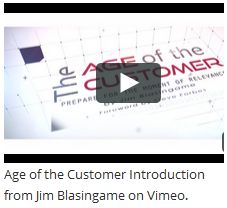VIDEO: Your future and customer paradigms
Award-winning author Jim Blasingame lists the top three primary shifts of the new age that a small business must monitor constantly in order to be successful in the Age of the Customer. You can purchase his new book The Age of the Customer here .
Click the image to start the video.
Celebrate your customers this week
 According to the ICSA, the purpose of National Customer Service Week is “to create a positive message that lasts all year long and to provide a productive opportunity to generate an even stronger commitment to customer service excellence.”
According to the ICSA, the purpose of National Customer Service Week is “to create a positive message that lasts all year long and to provide a productive opportunity to generate an even stronger commitment to customer service excellence.”You should never have “a customer from hell”
“This is one of those customers from hell.”
That’s what a small business owner said to me during one of my road trips across the country to check on how things are going out on Main Street.
“Ann” was responding to my query about her business. Her full quote was closer to, “Business is good. But right now I’ve got to spend most of the day dealing with this customer from hell.”
When I was a pup commission salesman right out of high school working in big ticket retail, I quickly realized all customers aren’t created equal; there are cool ones, high maintenance ones and impossible ones, like the one Ann was fuming about. My initial reaction was I didn’t like the latter two types and would try to avoid them. But upon more mature reflection I realized that if I was going to be successful selling on commission, I would have to do business with all kinds of customers, not just the easy ones. Honing this perspective over time, I developed the twin pillars of Blasingame’s Difficult Customer Strategy.
Pillar One: Make an extra effort to understand what troubles and/or motivates difficult customers and serve them within an inch of their lives. Most difficult customers will give you points for the effort and very likely their business in the bargain. And here’s an extra effort bonus: When a difficult customer likes you, you’ll have a customer for life, and the most valuable referral source.
Pillar Two: The hellish behavior of some customers typically manifests as excessive demands. When dealing with such people, charge them for their behavior. As I told Ann, charge difficult customers enough so that regardless of their level of maintenance, you hope they come back and ask for everything again. The key is to ask enough questions about their expectations before you set your price. Or at least remember the next time.
One former consulting client of mine could be difficult. Whenever we were face-to-face and he showed me his hellish side, I would exaggerate making a mark on my note pad, which he knew was to remind me to add a difficulty factor fee on his next invoice (he had a different name for it that can’t be used here). Eventually we joked about it, but he knew his behavior impacted his bill. He was a client for years and, difficult or not, I always liked his business.
Write this on a rock … You should never have a customer from hell.
Jim Blasingame is the author of the award-winning book, “The Age of the Customer: Prepare for the Moment of Relevance.”
Dispelling the myths of ownership
As the economy recovers, you’re likely to meet a starry-eyed human babbling on about becoming a business owner.
Probing for the object of this person’s entrepreneurial infatuation will precipitate the what, where, how and when questions and, finally, the most important question: Why do you want to own a business? Answers to this last question, unfortunately, often produce what I call “The Myths of Small Business Ownership.” Here are four:
Myth 1: When I’m an owner, I’ll be my own boss.
That’s right; you won’t have an employer telling you what to do. But you’ll trade that one boss for many others: customers, landlords, bankers, the IRS, regulators, even employees.
Modern management is less “bossing” and more leading and inspiring. In a small business, everyone must wear several hats and the dominator management model doesn’t work well in this modern multi-tasking environment.
Myth 2: When I own my own business, I won’t have to work as hard as I do now.
This is actually true – you will work much harder. Ramona Arnett, CEO of Ramona Enterprises, said it best, “Owning a business means working 80 hours a week so you can avoid working 40 hours for someone else.”
The irony is you’ll actually want to work harder when you understand everything in your business belongs to you. Even the irritating, frustrating, and frightening challenges will take on a new perspective when you realize you also own theopportunities you turn them into. You’ll turn the lights on in the morning and off in the evening not because you want to work more, but because you won’t want to miss any part of your entrepreneurial dream coming true.
Myth 3: When I own my own business, I can take a day off whenever I want.
Well, maybe. However, you may find that your business has such a compelling attraction that you won’t want to take off. Indeed, it’s more likely that whatever interests you had as an employee will become jealous of your business.
Myth 4: When I own my own business, I’ll make a lot of money.
If the only reason you want to own a business is to get rich, you probably won’t be a happy owner. It’s true – you actually could get rich, but it’s more likely that you’ll just make a living.
Being a successful business owner first means loving what you do. Pursuing wealth should be secondary and ironically is actually more likely to happen when in this subordinate role.
Write this on a rock … For maximum small business success, don’t fall prey to the myths of ownership.
AUDIO: The cost of not converting to Age of the Customer practices
What does it cost to reject The Age of the Customer shift? Jim Blasingame reveals that the only thing that costs more than converting to Age of the Customer practices is not converting.
Click the image to begin the audio.
Is crowdfunding investment capital right for your business?
In previous columns I introduced three crowdfunding sources including donation fundraising, startup transactions, and lending. Now let’s talk about the fourth and most problematic method: raising capital from investors.
Historically, small businesses acquired investor capital from two sources: venture capital and angel investors. So when crowdfunding popped up on our radar, many in the entrepreneurial universe got excited thinking the Internet could be used as a lever for investor capital as it has for other business applications. Here are four reasons why I was not among this group.
1. Securities Laws
Remember those two crowdfunding markers identified in my previous columns, “innumerable and anonymous?” Well, they’re the most problematic in raising investor funds because, by definition, the public (people you don’t know) has access to Internet offerings. U.S. securities laws are enormously restrictive about selling investments to the public, and the approval process is prohibitively expensive for most startups. Plus, even as part of Obama’s 2012 JOBS Act, the Securities and Exchange Commission (SEC) has yet to approve crowdfunding for investors and won’t say when rulemaking will happen.
 2. Financial reporting
2. Financial reporting
One of the essential markers of investingis financial reporting. Alas, one of the markers of the small business sector is poor financial recordkeeping. When small businesses learn the level of disclosure required for crowdfunding investment, most will not pursue this path.
3. Minority shareholders
Investors become shareholders. A crowdfunding offering is likely to create many shareholders. When small business owners understand the maintenance expense and effort to comply with mandated reporting to shareholders, most will seek other capital sources.
4. Exit strategies
Small business owners love their businesses, but most don’t have an exit strategy. Since capital is not romantic, it’s unlikely that a small business owner’s idea of an exit will align with that of crowdfunding investors. And with no after-market for these shares, crowdfunding creates an inherent exit expectation conflict, which will be a non-starter.
When and if SEC rulemaking occurs, crowdfunding equity will benefit some entrepreneurs. But I predict this capital source won’t be a high percentage option for most small businesses. Crowdfunding is part of the future of small business capitalization, but it’s not for everyone.
Write this on a rock … Don’t count on crowdfunding to replace your banking relationships.
Jim Blasingame is the author of the award-winning book, “The Age of the Customer: Prepare for the Moment of Relevance.”
Is a crowdfunding business loan right for you?
In my last column I introduced the concept of crowdfunding — the new word and online methods of fundraising and capitalization. The two crowdfunding examples I described were contributions and business transactions doubling as fundraising.
Let’s continue with the third type, which is, crowdfunding structured for loans.
 Crowdfunding debt, AKA peer-to-peer and social lending, is like traditional borrowing: a request for funds comes with the promise of repayment with interest over a specific term. But the former is done online, and the latter is not. Individuals use crowdfunding for personal loans, but our focus here is for business borrowing, which typically involve four crowds:
Crowdfunding debt, AKA peer-to-peer and social lending, is like traditional borrowing: a request for funds comes with the promise of repayment with interest over a specific term. But the former is done online, and the latter is not. Individuals use crowdfunding for personal loans, but our focus here is for business borrowing, which typically involve four crowds:
1. Business borrowers
2. An online crowdfunding platform aggregating loan requests
3. A funding and underwriting source, likely a hedge fund
4. Individuals who invest with #3, knowing it’s for loans to small businesses
Remember the innumerable and anonymous crowdfunding factors from the previous column? These two are also in play with crowdfunding debt, because a large crowd is required to provide a pool of loan funds and dilute the risk, and investors are only known to the funding source aggregator.
Regardless of the funding source, crowdfunding or traditional, small business loans are expensive for the borrower because this sector is considered high risk for two primary reasons:
1. Most small businesses are undercapitalized and operate on a thin survival margin
2. Too many small business owners don’t track financial performance well enough to know how they’re really doing.
And since crowdfunding loans are unsecured, taking the risk to an even higher level, crowdfunding business loans are doubly expensive.
So is a crowdfunding business loan right for you? Here’s some context: If you can borrow from your bank, this year you’ll probably pay an average of about 6% annual interest rate. A crowdfunding loan APR will likely be 15% or more. Any questions?
Crowdfunding business lending has achieved some level of critical mass and is growing. As I’ve said before, the future of small business capitalization will look a lot different than it does today largely due to this emerging alternative.
Next time we’ll wrap up this series with a tour of the good, bad, and improbable of investor equity crowdfunding. And more tough love.
Write this on a rock If you can borrow money from a bank, don’t borrow from a crowd
Jim Blasingame is the author of the award-winning book, “The Age of the Customer: Prepare for the Moment of Relevance.”











